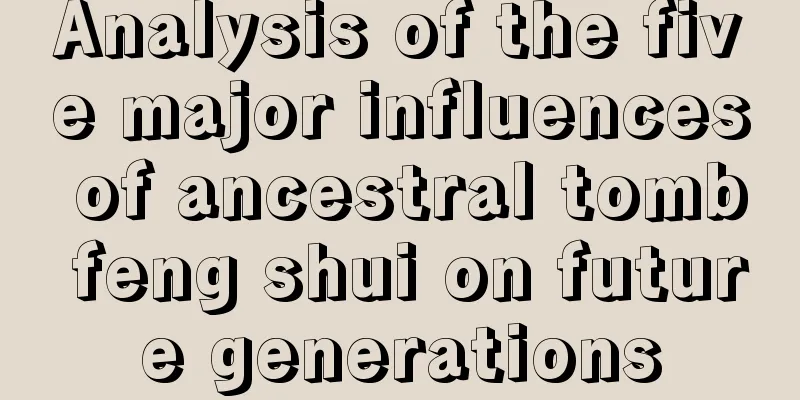Feng Shui Story: Detailed explanation of the Feng Shui of Yongling and Hetuala City

|
Introduction: The ancient city of Hetuala is located in Yongling Town, Xinbin Manchu Autonomous County, Liaoning Province. It is located to the west of the World Cultural Heritage and the National Key Cultural Relics Protection Unit. In this issue of Feng Shui stories, please follow the editor to learn about the Feng Shui of Yongling and Hetuala City. Please see below for details. Folk wisdom is compiled into stories, including many Feng Shui stories. Let’s take a look at them. Nurhaci (or his grandfather) had the will of heaven bury the remains of his ancestors in Yongling. From the perspective of feng shui, Yongling is naturally a blessed place with beautiful mountains and rivers and "lush royal aura". According to Mr. Zhang, who is well versed in Feng Shui, there is the head of the Azure Dragon on the left, the tail of the White Tiger on the right, and Longshan (Chimney Mountain) in front. These mountains are all 12 miles away from Yongling. There are 12 peaks on the mountain at the back, and the mausoleum is located among them. The Longxu River (Suzi River) in front flows through this place and is exactly 12 miles long. The number 12 symbolizes the 12 emperors of the Qing Dynasty, and all the data on the Feng Shui terrain of Yongling coincides with 12. In addition, there is a pilgrimage mountain in front - Jiming Mountain (also known as Phoenix Mountain). The Yudai River is like a jade belt winding around the Yongling Mausoleum. The Erdao River, Cuocao River and Suzi River form a "three waters into the reservoir" ("reservoir" means "tomb"). Mr. Zhang said with emotion: "This wonderful terrain is beyond the reach of human Feng Shui masters. This is God's will!" The sacredness of the legend and the mystery of the Feng Shui terrain are perfectly matched here. When Nurhaci established the Later Jin regime, he first set up his capital in Hetuala, so this place is also known as the first capital of the Later Jin. According to folk legend, Nurhaci originally built a castle in the city of Feala, a few kilometers away from Hetuala, but some unpleasant things happened there every day, so Nurhaci found a Feng Shui master and asked him the reason. The Feng Shui master said, "Prince Han, listen carefully every day to see if there is a rooster crowing. If there is, that is where you should go." One morning, the sound of a rooster crowing loudly came from the north of Jiguana Mountain. Nurhaci believed the Feng Shui master's words and brought his family and soldiers to this place to rebuild the capital. This place is the city of Hetuala. Later, Nurhaci unified other surrounding Jurchen tribes and established the Later Jin regime in 1616. There is another legend about the good feng shui of Hetuala.One day, Nurhaci's father, Taksi, went to a villager's house in Hetuala to stay overnight, and two Taoists happened to be there. The Taoists were very grateful for the host's hospitality and told them a secret: "This is an unusual place. The two lotus ponds in the north of the city are the two eyes of the dragon. On August 15th, when the lotus flowers are in full bloom, you can throw the remains of your ancestors on the lotus flowers, and the petals will close. In this way, your descendants will become the kings of the world." After hearing this, Taksi threw the remains of his ancestors on the lotus flowers before the villager. All the lotus flowers in the pond were shyly folding their beautiful petals. The villagers arrived a step too late, and just like that, the good feng shui was taken away by Taksi. Nurhaci later became the Khan of the Later Jin Dynasty because his father Taksi had good feng shui.The location of Hetuala City, the first capital of the Later Jin Dynasty, was the result of a prediction by a Feng Shui master. The inevitability of the establishment of the Later Jin Dynasty before the Qing Dynasty was also confirmed by Feng Shui. Thus, the legitimacy of the Qing Dynasty once again found a strong basis in the city of Hetuala. There are many versions of the story about the burial of Nurhaci's ancestors' remains, and what is important here is the metaphorical effect of these legends. The "Two Eyes of the Divine Dragon" (two lotus ponds) mentioned by the Feng Shui master were bombarded by Russian artillery during the Russo-Japanese War, causing the lotus pond to burst its banks and the water to flow out of the city. When the city of Hetuala was "restored" in 1999, the "Two Eyes of the Divine Dragon" were restored first to ensure good feng shui for Hetuala. Interestingly, a Feng Shui master was involved in the restoration project of Hetuala City from beginning to end. I was deeply impressed by him running around the construction site with an ancient geomancy book and a compass in his hands. The city of Hetuala was originally an ordinary village with 81 temples of various sizes scattered in various corners of the village. After the construction began, all the villagers moved to other places and the entire village was razed to the ground overnight. Naturally, these temples were not spared. It is said that after that, accidents often occurred on the construction site, such as truck breakdowns and many people suffering from dizziness. The Feng Shui master believed that it was the Huxian (fox), Huangxian (weasel), Changxian (snake), Mangxian and others who originally lived in the temple that were causing trouble. So, with the approval of the leaders, he built a "Pantheon" in a corner of the city to accommodate those homeless wandering gods. Hetuala City is an important part of Xinbin Manchu Autonomous County's tourism development using the history and culture of the Manchu people. Folk knowledge has gained an important position in tourism development carried out under the name of "traditional culture". Here, Feng Shui practice has been transformed from a daily life practice to a practice of creating traditional culture, and various "superstitious activities" that are usually prohibited have gained legitimacy in this special space. It can be seen from this that tourist attractions that boast of "traditional culture" are sometimes non-daily spaces that allow people to temporarily escape from national ideology. Today, the Manchus are identified as one of China's 55 ethnic minorities. At a time when the trend of "traditional cultural revival" is prevalent, there has rarely been a real discussion about what Manchu traditional culture is. No matter how complex its composition was, the Qing Dynasty, as a "foreign dynasty", embellished the last chapter of Chinese imperial history. This "foreign race" of course referred to the "Manchus". For the Manchus, who derive their identity from dynastic history, their traditional culture is precisely their "culture derived from history." For local governments and Manchu elites, recreating the glorious history of the dynasty may be much more important than reviving the disappearing (and often forced to remain underground) shamanism. In this context, the Manchus have transcended the framework of a "minority ethnic group" and emerged as the successors of the Qing dynasty's genealogy. The legitimacy of the dynasty means the legitimacy of the Manchu genealogy. The theories of destiny and feng shui are deeply engraved in the historical memory of the Manchus as their effective basis. Summary: The above article is a detailed description of the Feng Shui story of Yongling and Hetuala City. You can learn about it and also learn some history of the once prosperous Qing Empire. |
<<: Feng Shui layout for girls' rooms in the year of the Rooster 2017
>>: Feng Shui Story: Feng Shui Analysis of Lin's Former Residence
Recommend
When is the Double Ninth Festival in 2021? Is Double Ninth Festival the Ghost Festival?
The Gregorian calendar time of the Double Ninth Fe...
What are the customs of the Double Ninth Festival? Is it a good idea to open a business on September 9, the Double Ninth Festival in 2020?
Introduction: It’s the Double Ninth Festival again...
Is it appropriate to sign the contract on July 28th of the lunar calendar in 2022? What should I pay attention to when signing a contract?
Is the 27th day of the seventh lunar month in 2022...
Is it a good time to move house on the first day of the eleventh lunar month in 2021? How to choose an auspicious day for moving?
The eleventh month of the lunar calendar brings th...
The fate of boys born on January 20, 2022
Babies are born every day, and their fates vary de...
Is it a good idea to move house on the first day of the fifth lunar month in 2019? Can I move into a new home?
Pomegranate flowers are in full bloom in May of t...
In which position and direction is the God of Wealth on September 21st of the lunar calendar in 2021?
The ninth month of the lunar calendar is the third...
Is it a good time to set up a bed on the second day of the twelfth lunar month in 2020? Five suitable Feng Shui rules for setting up a bed
Introduction: Generally, you need to choose an aus...
When will we celebrate New Year’s Day in 2019? How will we take the New Year’s Day holiday in 2019?
New Year's Day is the beginning of the Gregori...
Is the eighth day of the fourth month in the Year of the Rat 2020 a suitable day for decoration?
Is the eighth day of the fourth month in the Year ...
Can I get a certificate on the Cold Food Festival in 2020 (the day before Qingming Festival)? How many days are left before the Cold Food Festival?
Introduction: Generally, you need to choose an aus...
What is the lunar calendar content for Mid-Autumn Festival in 2021? What is the auspicious direction for the God of Wealth during the Mid-Autumn Festival?
Mid-Autumn Festival is a traditional festival in m...
Is the Spring Equinox of 2018 a good day? Is it appropriate to burn incense and pray for blessings during the Spring Equinox of 2018?
Introduction: Burning incense and praying for bles...
Is it a good idea to open the new store on December 23rd, 2017?
2018 has just begun and the Year of the Rooster i...
Is the fourth day of the tenth lunar month in the Year of the Rat 2020 suitable for opening a company?
The auspiciousness and inauspiciousness of differ...









